|
Chapter 1
CHILE
Santiago - San Pedro de
Atacama - Arica
Tuesday
23 June
For
some reason the BA hostess offered to switch my seat for a better one
but I don’t fly often enough to know the numbers of the “good”
seats so it meant nothing to me. We
had to leave the plane for an hour or so at Buenos Aires, which I was
not expecting, but it was too dark to see anything of Argentina.
The sun came up as we crossed the Andes but from my centre aisle
seat I couldn’t watch Chile unfolding below me.
Wednesday
24 June
The
first thing I noticed exiting Santiago airport was the Andes.
A line of snow covered mountains just visible in the early
morning mist? smog?

A postcard - Santiago from the
funicular (probably)
A
taxi to the hotel was offered at $20 which seemed rather a lot,
especially when the local minibus was doing it for $5 or 2000 pesos. The exchange office at the airport offered P435 to $.
The minibus arrived at our chosen hotel, Los Arcos, first.
The hotel was OK but rather expensive, we weren’t planning on
staying for long! Our room
was dark and gloomy. The
shower had one leaking cold tap although the basin had hot water.
Jen had been there and they were happy to let me in to her room
but she was out. I waited
in the lobby finishing “Inca Kola”, Matthew Parris’ story of a
trip around Peru, and after an hour or so Jen came back.
We
set off into Santiago and attempted to find the right bus station for
our trip north but it eluded us. At
the cafe where we stopped for coffee, the main meal seemed to be stew
with cooked beetroot on the side. Eventually
we found another bus station with lots of long distance buses but no-one
spoke English and Jen’s Spanish was not up to explaining what we
wanted. We walked miles to the Tourist Information office in another
part of the city where the girl knew a couple of words of English but
not a lot. A Spanish map of
Arica and a Santiago tourist map (useless) were forthcoming. The Tourist Information girl was very friendly but not much
help.
A
small restaurant next to the Plaza de Armes was offering chicken and
chips for £2 and in between the first drink and the meal some Chilean
bastard nicked Jen’s bag containing her passport, travellers’
cheques, cash, camera, guide book, novel and diary.
It was all too awful to record.
That hopeless, helpless feeling that descended with the
realisation that it had really gone.
Jen ran after a policeman and disappeared into the darkening
gloom of the square. All the Chileans around us could see what had happened and
muttered darkly to themselves. One
spoke a little English and came over to explain that there were a gang
of well dressed men working in Santiago.
He was a painter and often hung around the square, selling his
wares. He said “I don’t
know why the police don’t do more, perhaps they have been bribed”. He apologised for his country.
A sombre evening passed full of discussions on what we should
have done and what we could have done.
I was terrified Jen was going to say “that’s it, I’m going
home” but fortunately she’s made of sterner stuff.
Thursday
25 June
Jen
and I had an unfortunate encounter with the Metro where we refused to
read the signs and kept leaping onto the wrong trains just because they
were there. The first time
we got away with it and managed to return to our starting point, Los
Heroes, the second time we exited the system and despite argument and
pleading in broken Spanish we had to buy another ticket for P190.
We were arguing over £0.26 each!
At
Tobalaba we walked to the British Embassy.
I was most disappointed that it was not a beautifully maintained
old colonial building but a brand new one owned by BAT - Edifico
Chiletobacos - opened by Princess Anne in 1991.
There was no sign of tea and sympathy but they had very hot
security and bullet proof glass. Replacing
the passport was no problem except for the photo.
The first place we tried had a girl on the phone “no chance
until next week” and “I don’t know anywhere else”, the Embassy
suggested a second who couldn’t do it but the second place suggested a
third that could and did. The whole day went by chasing after replacement things.
Friday
26 June
A
taxi took us to the Embassy to deliver the photos and then we took the
metro to Thomas Cook, with Simon’s help.
He was a Brit from Hereford who moved to Santiago four years ago
and makes heaps teaching English. He
also explained the difference between changing platforms and salida
(exit). Travellers cheques
were supposed to be available somewhere here.
We tried this Thomas Cook office and that Thomas Cook office and
even the Afex (exchange) office. Lots
of English and smiles but Wilma (the one with the cheques) was missing.
We left Afex and TC to sort it out whilst we returned to the
Embassy to collect the passport and see how the cash transfer from
Midland Redruth to Banco de Santiago was coming on.
Slowly. And of
course it was St Peter’s and St Paul’s Holiday on Monday so if it
didn’t happen that day it would be Tuesday.
We really didn’t want to stay in Santiago until Tuesday so we
arranged that the Embassy would transfer the money to Banco de Santiago
in Arica - that gave them more time to organise the transfer.
Back to Thomas Cook where
Wilma had done her bit and off to Afex to change some money.
They were closed for lunch but opened especially for us, they
could see how stressed we were, much to the amazement and annoyance of
those waiting outside.
I
can’t remember the first time it was suggested that Jen was my mum but
it happened several times in both Chile and Peru.
This irritated Jen and very soon we worked out how I could say
“she is not my mother, she is the sister of my boss” in Spanish to
answer any subsequent enquiries!
Our
picnic lunch was eaten in the park whilst we contemplated investigating
the funicular that went up the hill overlooking the city, but decided
the bus out was more important. Everywhere
in Santiago there were what appeared to be stray dogs running loose.
Nice looking dogs that slept on the pavements and managed to
avoid the traffic. At the
entrance to the park there were two, very smart, mounted policemen.
There were always men with machine guns outside banks.
Every man that passed looked the gringos up and down.
We were surprised at how short the Chileans were.
A
travel agent on Huerfanos tempted us with a return flight to Calama for
less than the overnight bus but it didn’t leave until Monday. We decided to take a bus but the bus station was constantly
engaged so we walked to it - the same one we failed to find before.
There was a socking great bus sign on top of a building and the
metro had the same name but could we find it?
How can you hide a bus station?
We asked various people who hadn’t a clue and eventually found
someone who knew where it was. They were virtually frog-marched down the street (I was a
little irritated at this stage) until they could point out the bus
station to us - just behind the cafe selling stew and beetroot we
stopped in on Wednesday when we couldn’t find it.
We purchased a ticket in the bed-bus for P22000 (£31.42) each,
leaving at 1515 the next day for Calama.
Saturday
27 June
Jen
and I walked into town to buy some provisions for the trip.
We bought some postcards from a book shop in one of the Malls and
met, for the first time, the Chilean (and Peruvian) obsession with
pieces of paper as well as three people doing a job that one could do.
One person gave you a chit, you took this to someone else to pay
and then presented the receipt to a third person who was beautifully
wrapping your 50p worth of postcards.
At
Cal y Canto there seemed to be a bit of a market. We found the fish market in which there were lots of short
people and lots of big fish, including huge slabs of swordfish and
things that looked like barnacles.
It was very clean. There
were dozens of stalls, all with the same fish, and a few people milling
around but not as many as you’d have thought for the amount of fish
for sale, contained within an ancient building with an air of Paddington
station. Its central hall
was filled with vegetable stalls and cafes selling multifarious seafood
dishes; and televisions - it was Chile versus Brazil that day.
We had a coffee but it was too early for a meal.
One of the touts for the cafe spoke excellent English so we
chatted to him for a bit whilst buying some food and taking photos of
fish stalls. We told him
our problems - he had a theft story too - as did everyone we talked to -
and he wanted to take our picture with my camera. He seemed very charming and trustworthy but I was not willing
to let go of the only camera we had left.
In view of his later appearance in the same place when we
returned to Santiago, I was probably wrong.
Jen
had studied her hostelling book the night before and on the way out that
morning we discovered the local youth hostel, about 2 blocks from our
hotel. It looked new, clean
and friendly and was cheap. It
was a pity we didn’t think of that before.
All the other youth hostels in Chile were south of Santiago but
there were some in Peru, though none in Bolivia.
Walking
to the bus station with all our stuff was quite an experience, the first
time we had walked any distance. Is
one really supposed to lean over like this to balance the pack?
The bed-bus had wider seats than normal with more leg room but
you still couldn’t lie down. Our
steward entertained us with US videos with Spanish subtitles (Meryl
Streep white water rafting, one about the Irish problem and another one
I can’t remember - must have been good!) and served dinner at 2100.
The
bus left on time and spent some time driving through the suburbs which
were very dirty and rundown. After
that we reached the country with lots of vines and a few horses.
We ran along the coast for a little while until it got too dark
to see any more.
Sunday
28 June
When
we woke up the bus was going along a road on a vast empty plain between
two mountain ranges. No
vegetation, no animals, no birds, just the road, the railway, the old
pipeline, the new pipeline and every now and again a transport caff in
the middle of nowhere. Sometimes
you could see signs of mining or earth works in the distance.
After
20 hours, bits of green appeared, we had reached Antofagusta.
The fourth largest city in Chile.
We had time to walk down the road to stretch our legs, photograph
the park, watch the carabineris come over, surely photos of the park
were not forbidden? No they were just crossing the road.
The bus carried on and we started over with the videos, Meryl
Streep white water rafting again, this obviously had an effect on us,
just as well she wasn’t bungee jumping.
Leaving
the city we had to drive through the community rubbish tip.
This was not an official site.
We noticed the rubbish was just dumped a little way outside the
city limits leaving the paper and plastic bags to blow across the desert
in the wind whilst a couple of scavenging dogs sorted through what
remained. We also noticed
the roadside shrines for the first time, or dog kennels as they were
known. We presumed they
marked the site of an accident although it was sometimes difficult to
understand how someone could have had an accident on a perfectly
straight road with no buildings or trees with which to collide.
Traffic coming in the other direction would have been visible for
miles unless they have problems with fog.
As the distances between towns are so great perhaps the drivers
fall asleep, come off the road and are unfortunate enough to hit the
only boulder in miles.
In
Calama we decided to try and get a bus on immediately and the town map
in our guide book was
adequate for us to find the stop and the place to buy a ticket.
We wandered through the market whilst we were waiting - the last
stall had a turkey, ducks, chickens, rabbits, guinea pigs, tortoises as
well as lots of little birds. We
were not sure what was food and what was pet.
At a stall on the other side were two Siamese kittens in a cage.
Our
bus was only an ordinary old coach but it was just as easy (or
difficult) to sleep. We
arrived at San Pedro de Atacama, 105km SE of Calama, before dark and
were held up by their firemen for money, collecting for themselves I
gathered. Once again our
map worked (from Jen’s replacement Chile book, purchased in Santiago)
and we found our way to Chiloe, recommended in our book, even though we
were handed information about a place with a German name, Corvatch.
P4000 (£5.71) each, hot water and another P1000 (£1.43) for
breakfast. Corvatch was
just over the road. We
investigated tours and were sent to a Tourist Information office a
couple of blocks up where English was definitely spoken.
We arranged a trip to the geysers at El Tatio for 0330 and
horseriding for me at 1430 the next day.
St
Peter & St Paul started their fiesta that night with dancing and
music in the streets, finishing with a service in the church. The town was full of heaps of tourists, mainly Chilean.
It was suggested we partied all night and then went to the
geysers in the early hours of the morning but we declined the offer and
fell asleep to the sound of music and laughter.
Monday
29 June
We
arose at 0300. The trip
started at Corvatch. It was
pitch black. They have
street lights in San Pedro but they are only alight until 2300ish.
They said take warm clothing but what did they think was cold?
In Santiago everyone was wearing jumpers and coats when Jen and I
went round in T shirts.
There
were seven passengers and a driver in a Hyundai minivan.
The road was a dirt track. It
was very cold. This time they really meant cold. We got stuck in the snow.
The driver seemed to like using the edge of the road rather than
the road itself. We all had
to get out and push. One of
our group seemed to have partied too well yesterday and declined.
After 3½ hours it was getting light and we had arrived at El Tatio (alt. 4500m).
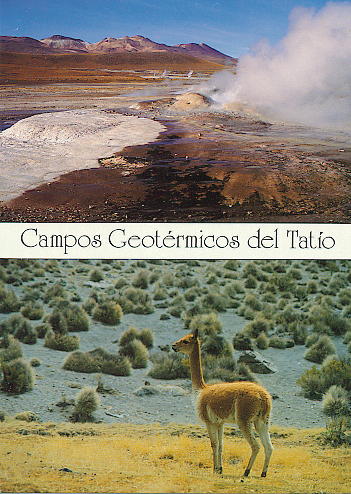
The
geysers and a vicuña
It
was bitterly cold. The
water coming from the hot springs was too hot to touch.
I retreated to the van. The
weather dictated how well the geysers gushed and ours didn’t seem to
be gushing too well although they did improve.
Breakfast was at 0730. We
were supplied with black coffee and a cheese roll.
And the cheese was so tasty too!
By now it had warmed up slightly outside and the rest of the
world was turning up - probably another 6 or 7 vans.
There were lots of holes gushing steam, more holes full of
gurgling mud and amazing views of Los Andes.
We drove a little way back to another geyser that was more
impressive and found the hot pool, made of concrete with the hot water
flowing in at one end. It
was still fairly cold but Jen insisted on a dip so I joined her.
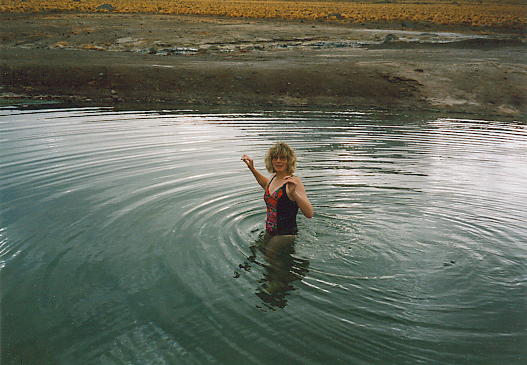
Hot
pool (pale bits are snow!)
People
in coats, hats, scarves and gloves came to look but did not join in.
There was snow on the ground a little way off.
At
0900 we set off on the return journey to see what we could only feel
earlier that morning. It
was like the Wheal Maid Valley (at Goongumpas) magnified a million times
(apart from the cacti and the volcanoes!).
Stones, Atacama giant cacti, snow for miles, we drove down into
and across valleys, round winding hills, on and on, getting lower all
the time with huge volcanoes (mainly ex) watching over us.
Jen spotted a few vicuña, one rabbity animal, probably a
viscacha, and three different types of birds but that was all for miles.
St
Peter & St Paul were at it again in San Pedro, dancers (girls in
very short skirts showing their elaborately lacy knickers and chaps with
brightly coloured costumes with bells on their boots), various bands and
holy figures. Some of the
procession were unfortunate enough to be dressed in thick blanket-like
material and it was hot.
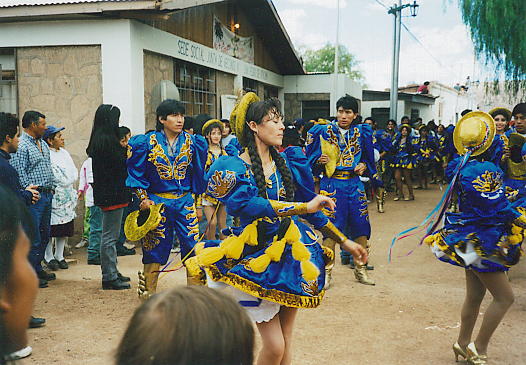
Downtown
San Pedro de Atacama
There
was one chap and two horses outside my hotel at 1430. The horses had normal looking bridles and English saddles.
Mine was the bigger one, a 16hh, 8 year old bay called Lorenzo.
His was only slightly smaller, a black horse called Bonita.
He spoke no English.
We
walked out of town criss-crossing the river, along small paths and
reached the ancient Atacamian village.
The original, pre Inca, pre Spanish village, did he say 1300?
The village appeared to be run as a tourist site and at the
bottom a woman seemed to be asking for money.
She didn’t get any, the hotel came into the explanation
somewhere but I didn’t understand anything more.
She had a pony, a donkey, llamas and alpacas in stalls with one
alpaca running free. I did
wonder if it was going to join us. I climbed up to the village to look around and could hear the
bands still processing in the distance.
We rode on into the emptiness along stony, sandy paths and into
the hills. Lorenzo tried to
eat any vegetation he saw, but there was none at this point.
Bonita shied at everything unusual but Lorenzo was not phased.
We
rode past Cordillera de la Sal, the Salt Mountains, and across the dried
up salt lake where it was totally silent.
No birds, no traffic, just the two of us and the Andes.
It was wonderful. I enjoyed myself enormously and regretted not choosing a
longer ride.
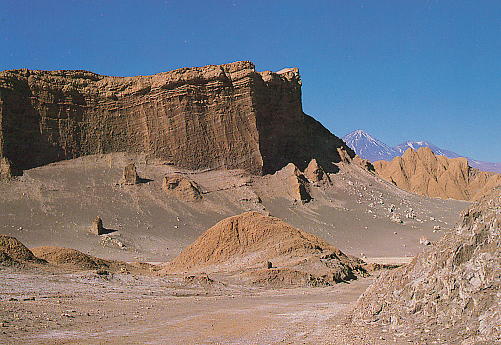
The
Salt Mountains and the Moon Valley
My
guide was passionate about horses and had six.
He said “there are tourists in San Pedro all year round and
many at times”. Lascar
(5154m), the one live volcano last blew 4 years ago.
The big one, Licancábur (5916m), last erupted when the Spanish
came in the 15th or 16th century. The
Spanish thought it was a plot by the locals.
Back
home at Chiloe I took a very welcome hot shower and did some washing in
the tiny wooden shed at the back of the hostel.
In the evening Jen and I attempted for the second time to have a
local dish, pataska, something made with maize, for dinner but we were
too early - some restaurants didn’t open until 8 and we were starving
by then.
Tuesday
30 June
The
previous day Jen had booked our 2215 bus from Calama to Arica.
We wandered around the town to buy a ticket to Calama and found
the bread shop, we knew there had to be one because we kept seeing
people with bread but didn’t think of looking next to the bus station.
The
guide book said the museum was good and had English literature.
Right and wrong. Museo Arqueológico was the collection of Padre Gustave
Paige, a Belgian missionary who lived in San Pedro between 1955 and
1980. It was a fascinating
repository of artefacts, well organised to trace the development of
prehispanic Atacameño society. There was an excellent topographical map
showing our trip to Tatio, lots of mummies and then the religious
Spanish influence. They
also had copies of wall paintings carved in polystyrene with pictures
and sketches of the real thing - a beautiful one of llamas and vicunas -
and details in Spanish. The
display was excellently presented.
We
arrived at Calama at lunch time and spent the afternoon changing money
and writing postcards before plodding round the town wearing our packs
looking for the TurBus station. I
rang John from one of the easy to use international phone booths which
cost P500 (£0.71) for 133 seconds.
We found every other bus station and began to get a little
annoyed. Chileans seemed
hopeless at giving directions. Just before giving in and getting a taxi we found it.
Then we had to march back into town, fully laden, for dinner
because we were too tight to pay P1100 (£1.57) to leave our stuff and
there were no restaurants around the bus station.
Fried chicken, chips and rice anyone?
Returning
to the bus station later we chatted to a Chilean who had worked in
Canada and spoke English. He
was from Santiago but found it too hectic there so moved to Iquique.
Now, he said Iquique was getting busy too. He invited us to visit him in Iquique but we weren’t
planning on going there. Instead
we had another 12 hour bus ride, through the desert to Arica.
Wednesday
1 July
Everything
in Arica was closed when we arrived at 0600ish so we camped outside our
chosen residencia and got a bed for P2500 (£3.57) with hot shower,
eventually. Outside our
room the wall was missing and we could see the new skyscraper wall next
door. It was very hot and,
in Arica, people didn’t wear coats like they did in Santiago.
Jen’s
money had not arrived yet, what a surprise.
We traversed the town trying to glean information about Lauca
National Park and travel over the border.
We were offered a one day tour of Putre to Lake Chungara and many
other places in the north eastern corner of Chile for P10000 (£14.28)
but it seemed a bit quick to do all that in one day.
We sat on the beach with the Pacific pounding next to us to have
our picnic lunch and Jen dared to have a swim.
The
policeman outside the station for trains to Bolivia said “there are no
trains, they have been suspended”.
Also outside the station was an old steam locomotive (made in
Germany in 1924) once used on this line.
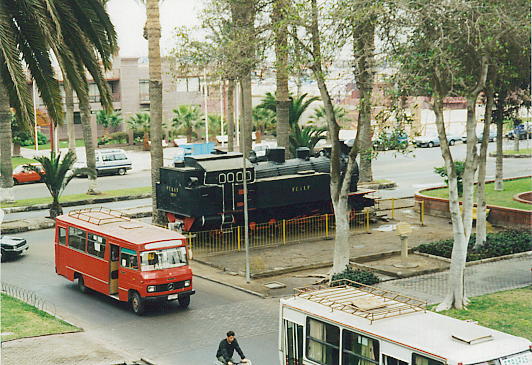
Next
to the station was the old customs house, designed by Eiffel (of tower
fame). It was now used as
an exhibition hall and the current exhibition was 40 odd photographs of
dandelions. From the first
leaves, through yellow flowers and white clocks, to the eventual death
of the flower, various single and groups of dandelions had been
photographed close up. Some
of the photos had the exciting addition of a bee or a butterfly.
I wouldn’t have believed one could take so many different
pictures of a dandelion! In
the corner of the entrance hall was a metal circular staircase leading
to an upstairs room used as an artist’s studio.
From there we could walk out onto the balconies either side and
look down over the square.
Dinner
that night was two plates for P1000 (£1.43), meat soup followed by chop
and rice. Whilst we were
eating the touts came in to sell us copper wire made into our names as
brooches, jigsaws, music cassettes and one chap with blades in plastic
cases who insisted he could speak English and wanted to tell us about
the football. He kept flashing his knives under our noses to illustrate his
points, which was rather disconcerting but he wasn’t threatening.
At
the Residencia Venecia it was pointed out there was a bell and we
didn’t have to keep rattling the door to be let in, and we thought it
was a light switch.
Thursday
2 July
Our
hot shower did not materialise and I was forced to beard “Arriba,
arriba” (so called because he looked like someone from a foreign
“B” movie whose only line is arriba, arriba, which means upstairs)
in his den to find out why not. He
could not make the shower work either and suggested I used one of the
downstairs ones which were fine.
We
set off for the Tourist Office with a list of questions.
The girl there spoke a little English and her boss spoke more but
left her to it. She rang
the collectivo to arrange our collection at 0630 mañana for travel to
Putre. There were no trains
to La Paz but there were buses. We
fancied taking a train so voted to go to Peru and then changed our minds
later. She said there were
no thermal baths actually in Arica, they were at Puquios near Putre and
Parinacota near Lake Chungara. The
horse sign on our Arica map was for horse racing and not riding.
We walked back to the Bank where Señor was being unhelpful.
All he said was “come back later”.
Jen rang the Embassy at Santiago for them to put pressure on and
it worked. After more
waiting and lots of paper Jen got her dollars.
We
took a walk up to the top of the Morro, the huge hill which overlooked
Arica. The whole town was
spread out below us. Because
of the new skyscraper next to our Residencia we could spot where we were
living very easily. There
was also a museum with exhibits concerning the battles at the end of the
19th century when Chile was fighting Peru for this area.
Our quiet and contemplative visit was interrupted by the arrival
of a group of primary school chldren who delighted in running up and
down past the exhibits, pausing only to exclaim at the guns and displays
of past battles.
At
the foot of the Morro was the cathedral of San Marcos built in iron by
Eiffel. Though small it was
beautifully proportioned and attractively painted.
It was brought to Arica from Ilo (Peru) in the 19th century,
before Peru lost Arica to Chile, as an emergency measure after a tidal
wave swept over Arica and destroyed all its churches.
Chapter 2
Top of page
Home |